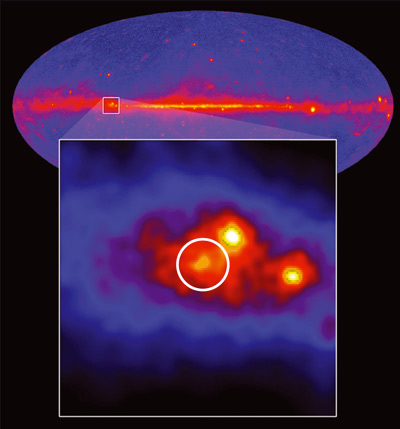
Zooming in on Fermi's all-sky map shows the location of the microquasar Cyg X-3 in the Cygnus constellation along the Milky Way.
Image credit: NASA/DOE/Fermi LAT collaboration.
The two currently operating high-energy gamma-ray satellites have both detected Cygnus X-3 (Cyg X-3) during episodes of strong radio flaring. These first detections of a genuine microquasar in our galaxy demonstrate that even small-scale relativistic jets are powerful particle accelerators.
Cyg X-3 is a peculiar binary system in our galaxy that might end its life as a gamma-ray burst (CERN Courier November 2009 p10). What makes this X-ray binary special is not the compact object that is a black hole or a neutron star, but the companion object, which is a rare Wolf-Rayet star. Such massive stars are in a late stage of their evolution and are characterized by a strong stellar wind blowing away the outer layers of gas, which are already enriched with heavy elements such as nitrogen, carbon and oxygen.
With a short orbital period of less than 5 hours, the black hole or neutron star of Cyg X-3 is moving very close to the hot surface of the Wolf-Rayet star, and deep inside its wind blowing at about 1000 km/s. Inhomogeneities in the wind hitting the compact object are likely to be the cause of the extreme variability of Cyg X-3. The chaotic accretion of gas from the wind sometimes leads to the formation of relativistic jets, which have been resolved by radio telescope arrays. This characteristic makes Cyg X-3 a microquasar, in analogy with the powerful jets of quasars, the active hearts of remote galaxies (CERN Courier July/August 2006 p10).
The Italian Astro-rivelatore Gamma ad Immagini Leggero (AGILE) satellite detected four major gamma-ray flares of Cyg X-3 at photon energies above 100 MeV. As M Tavani and colleagues reported in Nature, the flares lasted only a couple of days and were found during a long-term observing campaign of the Cygnus region between mid-2007 and mid-2009. They were all observed at epochs when the hard X-ray flux monitored by NASA’s Swift satellite was low. Furthermore, three of the four gamma-ray flares preceded a radio flare by less than 10 days. As the radio flares are known to be emitted by relativistic particles in the jet, this coincidence strongly suggests that the gamma-ray flare is also emitted by the jet or is related to the jet-formation process.
NASA’s Fermi satellite was launched in 2008, one year after AGILE, and also detected several flares of Cyg X-3 at energies above 100 MeV. Thanks to the superior sensitivity of its Large Area Telescope (LAT), the Fermi LAT collaboration was able to detect a periodicity in the gamma-ray signal corresponding to the 4.8 hour orbital period of the Cyg X-3 binary system. This detection, reported in Science, locates the origin of the flares within the complex gamma-ray emission region surrounding Cyg X-3. The Fermi data also confirm the link found by AGILE between gamma-ray flares and flaring activity observed at radio frequencies.
The corroborating results on Cyg X-3 by the two missions provide the first evidence that a genuine microquasar can emit high-energy gamma rays. This detection has important implications for the jet acceleration mechanism, although the actual emission process, in particular whether the emission comes from electrons or protons, is still the subject of debate.







